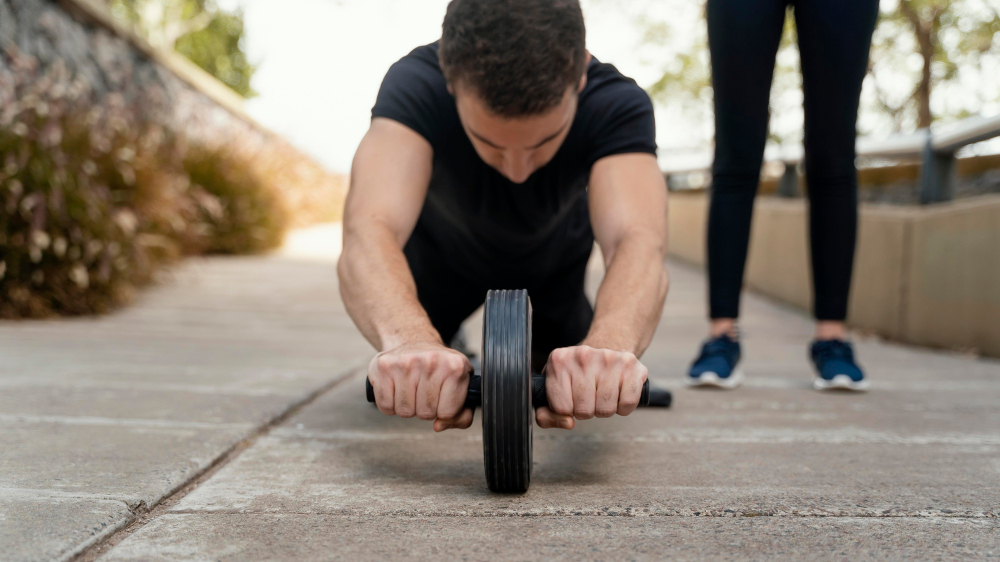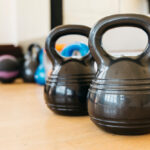So you bought an ab wheel. Watched a couple of YouTube videos. Thought, “How hard can it be?” Then you rolled forward, your arms gave out, and you crash-landed somewhere between embarrassment and regret.
The ab wheel looks simple, but it’s a ruthless little test of core control, shoulder stability, and ego management. If you’re collapsing halfway, you’re not weak. You’re just missing the right prep and technique.
In this guide, we’ll break down ab wheel exercises for beginners and how to master the main move that looks cool and brings amazing results.
Variations of Ab Wheel Exercises for Beginners
The ab wheel isn’t supposed to be easy. That’s why it’s effective. And the key to getting there is smart progressions, not brute-forcing the full movement.
Here’s what to do instead:
- Wall Rollouts (Kneeling, to a Stopping Point)
Start on your knees, facing a wall. Roll the wheel forward until it lightly touches the wall, then roll back. The wall acts as a brake, helping you control depth and avoid the collapse.
- Limited Range Rollouts
No wall? Just mark a short distance (like halfway down a yoga mat) and only roll out to that point. Focus on slow, controlled reps and don’t rush to full extension.
- Eccentric-Only Rollouts
Roll out as far as you can with control, then drop your knees to reset. Don’t worry about pulling back yet. Just focus on resisting gravity on the way down.
- Stability Ball Rollouts (If the Wheel’s Too Much)
If the ab wheel is too aggressive, grab a stability ball instead. Roll your forearms forward on the ball and then return. Same core engagement, less intensity.
- Pause Reps
Even in limited ranges, try adding a 1-2 second pause at the end of the rollout. It forces your core to engage harder and builds the endurance you’ll need later.
The Right Way to Use an Ab Wheel
The ab wheel doesn’t forgive bad form. You mess up your setup, and you’re either collapsing face-first or wrecking your lower back. Before you even think about rolling out, here’s what you actually need to dial in:
- Start in a Hollow Body Position: Don’t just kneel and hunch. Get your ribs down, glutes lightly squeezed, and abs braced like you’re about to get punched. This is your foundation.
- Keep Your Arms Straight: Your arms are there to guide the wheel, not press or curl it. Bending at the elbows shifts the load off your core and onto your shoulders and triceps.
- Control the Descent: Going fast just means you’re relying on momentum, not strength. Roll out slowly.
- Don’t Roll Too Far, Too Soon: Going full extension before you’re ready is a quick way to hate the ab wheel forever. Only go as far as you can while maintaining full-body tension. Half the distance with perfect form beats full distance with a collapsed core.
Final Thoughts
An ab wheel is all about a slow grind that rewards smart progressions, tight form, and a core that actually knows how to brace. The best way is to start where you are, build tension, and focus on control over range.
You don’t need to master the full rollout today. You just need to stop faceplanting and start moving with intent. Do that, and the strength will follow.
FAQ
Why is the ab wheel so hard at first?
Because it exposes every weak link in your core, shoulders, and hips. Most people don’t brace properly, go too far, or try to muscle through it with poor form. It’s a control movement, not a power one.
Do ab wheel rollouts work your abs better than crunches?
Yes. Rollouts train your entire core (not just your six-pack muscles) in a way that mimics real-world strength. Plus, they teach proper bracing, which carries over to lifting and sports.
Should I use the ab wheel on my feet or knees?
Start on your knees. The standing rollout is a brutal and most advanced version that most people aren’t ready for. Build strength through kneeling variations first.





